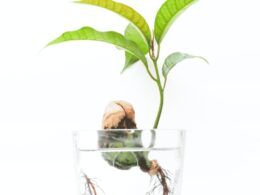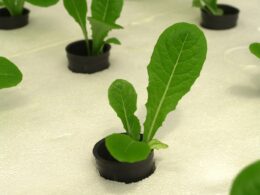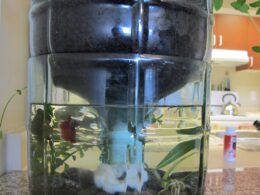Are you seeing green slime in your hydroponic system and wondering why it keeps coming back? Algae growth is a common problem in hydroponic systems, and it can be frustrating to deal with.
Not only does it look unsightly, but it can also clog your system and compete with your plants for nutrients and light. But fear not, there are simple steps you can take to prevent and control algae growth in your hydroponic setup.
In this article, we will explore the reasons why algae grows in hydroponic systems and the measures you can take to keep it at bay. We will discuss the importance of choosing the right plants, monitoring and adjusting your system, and using algae-preventing products.
By understanding the causes of algae growth and implementing preventative measures, you can keep your hydroponic system healthy and thriving. So, let’s dive in and find out why you’re getting algae in your hydroponic system and how to fix it.
Understanding the Causes of Algae Growth in Hydroponic Systems
Discover the reasons why your hydroponic setup might be experiencing an overgrowth of unwanted greenery. Hydroponic algae management is a crucial aspect of maintaining a healthy and thriving hydroponic system. Algae growth can occur due to various environmental factors, such as excessive light, high nutrient levels, and warm temperatures.
One of the primary causes of algae growth in hydroponic systems is excessive light exposure. Algae require light to grow, and when they receive more light than necessary, they can quickly overgrow. To prevent this, it’s essential to manage the amount of light your hydroponic system receives. You can do this by reducing the amount of time your system is exposed to light or by using light-blocking materials to cover your system.
Another factor that contributes to algae growth is high nutrient levels. When your hydroponic system has an excess of nutrients, algae can use them to grow rapidly. To prevent this, it’s essential to maintain the correct nutrient levels in your hydroponic system. Regular monitoring of nutrient levels and adjusting accordingly can help prevent algae growth.
Lastly, warm temperatures can also encourage algae growth. Algae thrive in warm environments, so it’s crucial to maintain the correct temperature in your hydroponic system. You can do this by using cooling systems or by placing your hydroponic system in a cooler area.
By managing these environmental factors, you can effectively prevent the overgrowth of algae in your hydroponic system.
Implementing Preventative Measures
Let’s start taking steps to keep the slimy green invaders at bay. One of the most effective ways to prevent algae growth in your hydroponic system is by controlling the pH level. Algae thrive in a pH range of 7.0 to 8.5, so it’s important to keep the pH level between 5.5 to 6.5. You can use pH test strips or a pH meter to monitor the pH level regularly. If you notice the pH level is too high, add some pH down solution until it reaches the desired level.
Another way to prevent algae growth is by ensuring proper water circulation. Algae need nutrients and oxygen to grow, and stagnant water can provide them with both. Make sure your hydroponic system has adequate water circulation to prevent stagnant water. You can use an air pump, water pump, or a combination of both to create a steady flow of water. This will not only prevent algae growth but also ensure your plants receive enough oxygen and nutrients.
In addition to pH control and water circulation, it’s also essential to maintain good hygiene in your hydroponic system. Keep the system clean by regularly wiping down surfaces and removing any debris or dead plant matter. This will prevent the buildup of organic matter, which can lead to algae growth.
By implementing these preventative measures, you can keep your hydroponic system free from algae and ensure your plants thrive.
How Can I Get Rid of Algae in My Hydroponic System?
When faced with the problem of killing algae in hydroponics, there are a few effective approaches you can take. First, maintain proper water hygiene by regularly checking and adjusting nutrient levels. Additionally, ensure proper air circulation and lighting to prevent algae growth. Adding beneficial bacteria or hydrogen peroxide can also help control algae. Regularly cleaning and sterilizing your system will further aid in combating algae in your hydroponic setup.
Using Algae-Preventing Products
To keep those pesky green invaders at bay, you’ll need to explore the world of algae-preventing products, which can help you maintain a healthy and thriving hydroponic setup. Here are some things to keep in mind when choosing the right products for your needs:
-
Product effectiveness: When choosing an algae-preventing product, it’s important to look at the effectiveness of the product. Some products may only work for a limited time, while others may not work at all. Do your research and read reviews from other hydroponic gardeners to find the most effective products.
-
Alternative solutions: While using algae-preventing products can be a great way to keep your hydroponic system clean and healthy, there are also alternative solutions you can try. One option is to use a UV light to kill off any algae that may be growing in your system. Another option is to change the water more frequently to prevent algae growth.
Ultimately, the key to keeping algae at bay in your hydroponic system is to stay vigilant and proactive. By using algae-preventing products, trying alternative solutions, and staying on top of maintenance, you can ensure that your hydroponic garden stays healthy and free from pesky green invaders.
Choosing the Right Plants
You’ll want to consider the right plants for your setup to ensure a successful and thriving hydroponic garden. The plant selection is crucial as some plants are more susceptible to algae growth than others.
For instance, leafy greens such as lettuce, spinach, and kale grow quickly and use up nutrients rapidly, leaving less for algae to thrive on. On the other hand, slow-growing plants like tomatoes and peppers may not utilize nutrients as quickly, making them more prone to algae growth.
In addition to plant selection, another factor to consider is nutrient requirements. Different plants have varying nutrient requirements, and too much or too little nutrients can also contribute to algae growth. It’s essential to research and understand the nutrient needs of your chosen plants and adjust your hydroponic system accordingly.
Providing the right balance of nutrients will not only help prevent algae growth but also promote healthy plant growth. By selecting the right plants and providing them with the correct nutrients, you can significantly reduce the chances of algae growth in your hydroponic system.
Remember to research and understand the nutrient requirements of your chosen plants and adjust your hydroponic system accordingly. With a little bit of knowledge and effort, you can create a thriving hydroponic garden that is free from algae-related issues.
Monitoring and Adjusting Your System
To keep your hydroponic system healthy and free from algae, you need to monitor and adjust it regularly.
Testing your nutrient levels is crucial to make sure your plants are getting the right amount of nutrients.
Adjusting the light exposure is also essential to prevent algae growth.
If you notice any issues, make necessary changes to prevent future algae growth.
Regular testing of nutrient levels
By regularly testing nutrient levels, you can prevent the growth of unwanted algae in your hydroponic setup. The frequency of testing should depend on the type of plants you’re growing and the size of your system. Some plants may require more frequent testing than others.
It’s recommended to test nutrient levels at least once a week for small systems and at least once every two weeks for larger systems. Nutrient level accuracy is also important to consider when testing. Make sure to use accurate measuring tools and follow the instructions for your nutrient solution.
If the nutrient levels are too high, it can lead to the growth of algae and other unwanted organisms. If the levels are too low, your plants may not receive the necessary nutrients for healthy growth. Regular testing and adjusting of nutrient levels can help ensure a healthy and thriving hydroponic system.
Adjusting light exposure
Adjusting light exposure is crucial in keeping your hydroponic system free from algae growth. It plays a vital role in ensuring your plants grow healthy and strong. Here are three ways to adjust your light exposure to keep your hydroponic garden in top shape:
-
Reduce intensity: Algae thrive in high-intensity light, so it’s important to keep your grow lights at a safe distance from your plants. If your plants are getting too much light, consider using shades or filters to reduce the light intensity.
-
Change duration: Algae also need long hours of light to grow, so it’s important to limit your plants’ light exposure. Consider using timers to ensure your plants receive the recommended amount of light each day.
-
Monitor light cycles: Pay attention to the amount and duration of natural light your plants receive. If your plants are receiving too much natural light, consider moving them to a darker location or using shades to block the light.
By adjusting your light exposure, you can keep your hydroponic system free from algae growth and ensure your plants grow healthy and strong. Remember to monitor your light cycles regularly to ensure your plants are receiving the right amount of light.
Making necessary changes to prevent future algae growth
It’s important to take action now to prevent future growth of that pesky green invader and keep your plants thriving.
One of the first things you should do is check your pH levels. Algae thrives in a pH environment that is too high or too low. Make sure your pH levels are within the appropriate range for your plants. This will not only prevent algae growth but also ensure that your plants are getting the nutrients they need to grow properly.
Proper ventilation is also key in preventing algae growth. If your hydroponic system is not properly ventilated, it can create a humid environment that algae loves. Make sure to have a fan or some sort of ventilation system in place to keep the air moving. This will not only prevent algae growth but also help your plants grow stronger and healthier.
Taking these simple steps will help you prevent algae growth and keep your hydroponic system thriving.
Frequently Asked Questions
Are there any natural ways to prevent or get rid of algae in my hydroponic system?
Looking for a DIY algae prevention method that’s safe and natural? Chemical treatments can be harsh and expensive, but there are some easy and effective alternatives you can try.
First, make sure you’re using a hydroponic system that allows for adequate air circulation and light exposure. This’ll help prevent algae growth by depriving it of the conditions it needs to thrive.
Another option is to introduce aquatic plants into your system. These plants can outcompete algae for nutrients, and their roots can also help filter the water.
Finally, you can try adding hydrogen peroxide or vinegar to your system in small amounts. These natural substances can help control algae growth without harming your plants, but be sure to do your research and use caution when experimenting with new methods.
With these natural alternatives, you can keep your hydroponic system free of algae without resorting to harsh chemicals.
Can using tap water instead of filtered water contribute to algae growth in my hydroponic system?
Using filtered water in hydroponic systems has many benefits over tap water. Tap water can contain high levels of minerals, chlorine, and other chemicals that can contribute to the growth of algae. On the other hand, filtered water is free from these contaminants and provides a clean and pure environment for your plants to grow.
It’s essential to use filtered water to maintain optimal plant growth and prevent unwanted algae growth in your hydroponic system. So, tap water vs. filtered water: which is better for plant growth? The answer is simple: filtered water is the better choice for your hydroponic system.
By choosing filtered water, you’re ensuring that your plants receive the best possible environment to thrive and grow.
Is it safe to use bleach or hydrogen peroxide to kill algae in my hydroponic system?
If you’re dealing with an algae problem in your hydroponic system, you may be wondering if using bleach or hydrogen peroxide is a safe option. While both of these chemicals can effectively kill algae, there are some potential drawbacks to keep in mind.
Bleach can be harsh and potentially damaging to your plants, and hydrogen peroxide can also cause damage if not used in the correct concentration. Additionally, using chemicals to treat algae doesn’t address the underlying issue of why it’s growing in the first place.
Instead, consider natural methods for preventing and controlling algae growth, such as reducing light exposure, properly balancing nutrients, and regularly cleaning your system. By taking a holistic approach to maintaining your hydroponic system, you can keep it healthy and thriving without relying on potentially harmful chemicals.
Can overfeeding my plants contribute to algae growth in my hydroponic system?
Overfeeding your plants in a hydroponic system can contribute to the growth of algae. The excess nutrients can accumulate in the water and create an ideal environment for algae to grow. Underfeeding your plants can also have negative effects. It can lead to stunted growth and weaken the plants’ ability to resist pests and diseases. Proper plant spacing is also important to prevent algae growth. When plants are too close together, they can create shade and reduce water circulation. This can promote algae growth. To ensure a healthy and algae-free hydroponic system, it’s crucial to find the right balance of nutrients and spacing for your plants.
How often should I completely clean and sterilize my hydroponic system to prevent algae growth?
To prevent the growth of algae in your hydroponic system, it’s important to maintain a regular cleaning schedule. The frequency of system maintenance will depend on the size of your system and the number of plants you have. Generally, it’s recommended to completely clean and sterilize your system every 2-3 months.
Additionally, the temperature of your system can greatly impact algae growth. To avoid creating a favorable environment for algae, try to keep your system at a consistent temperature and avoid exposing it to direct sunlight.
By keeping up with regular maintenance and monitoring the temperature of your system, you can help prevent the growth of algae and ensure the health and growth of your plants.
Conclusion
So, there you have it! Algae growth in your hydroponic system can be caused by several factors such as excess light, high nutrient levels, and warm temperatures.
But don’t worry, there are steps you can take to prevent and control the growth of algae in your system. By implementing preventative measures such as covering your system, using algae-preventing products, and choosing the right plants, you can keep your hydroponic system algae-free.
Remember to also regularly monitor and adjust your system to ensure it’s working properly. With these simple steps, you can enjoy a healthy and thriving hydroponic garden without the hassle of pesky algae growth.









